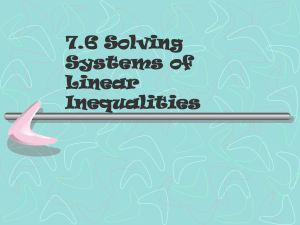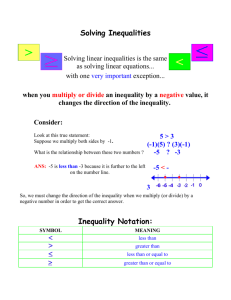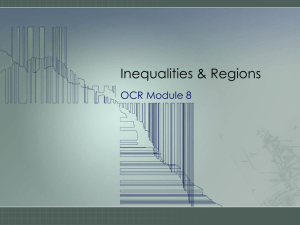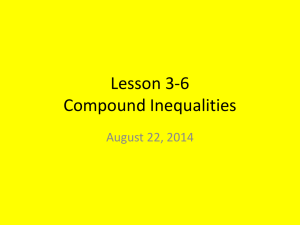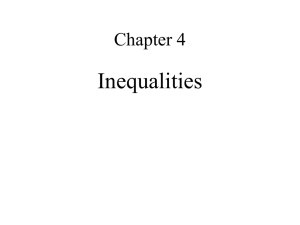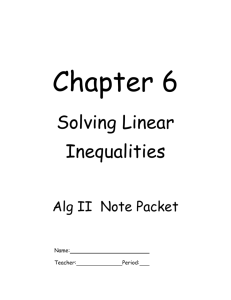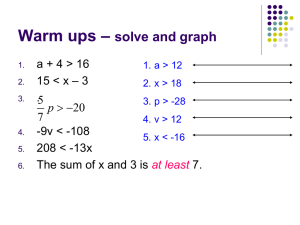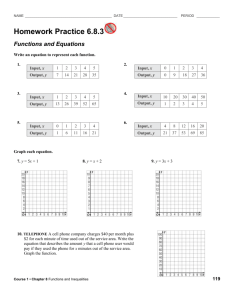MA112_LN1pt2 - University of South Alabama
advertisement
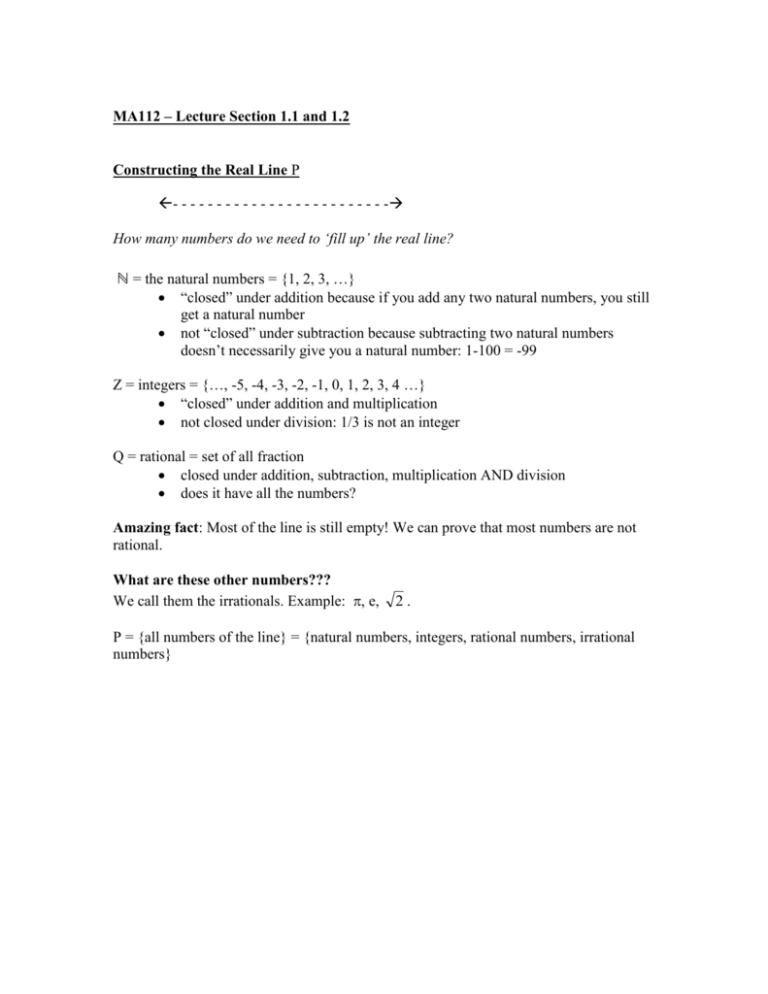
MA112 – Lecture Section 1.1 and 1.2
Constructing the Real Line
- - - - - - - - - - - - - - - - - - - - - - - - -
How many numbers do we need to ‘fill up’ the real line?
ℕ = the natural numbers = {1, 2, 3, …}
“closed” under addition because if you add any two natural numbers, you still
get a natural number
not “closed” under subtraction because subtracting two natural numbers
doesn’t necessarily give you a natural number: 1-100 = -99
Z = integers = {…, -5, -4, -3, -2, -1, 0, 1, 2, 3, 4 …}
“closed” under addition and multiplication
not closed under division: 1/3 is not an integer
Q = rational = set of all fraction
closed under addition, subtraction, multiplication AND division
does it have all the numbers?
Amazing fact: Most of the line is still empty! We can prove that most numbers are not
rational.
What are these other numbers???
We call them the irrationals. Example: , e,
2.
= {all numbers of the line} = {natural numbers, integers, rational numbers, irrational
numbers}
Describing Parts of the Real Line
We can describe a part of the real line using an interval.
Example: [-2,2] described the part of the real line between -2 and 2.
(graph)
If the endpoints of the interval are included, we say that the interval is closed and use
square brackets ‘[‘, ‘]’.
(graph [-2,2] in real line with filled circles)
If the endpoints are not included, we say the interval is open and use open brackets
‘(‘,’)’.
(graph (-2,2) in real line with open circles)
An interval can include one endpoint but not the other:
(graph [-2,2) on real line with one closed and one open circle)
Or we can describe a part of the real line using an inequality.
Inequalities:
x<3 means that x is less than 3
Figure out some way to remember
x>3 means that x is greater than 3
the difference between ‘<’ and ‘>’!!
x=3 means that x is 3
3 ways of describing a part of the line:
Intervals
Inequalities
[-1,5]
-1 x ≤ 5
[-1,5)
-1 ≤ x < 5
(-1,5]
-1 < x ≤ 5
(-1,5)
-1 < x < 5
Sketch
Homework examples
Express the interval using inequalities, and sketch on the real line.
1.
[-1,5]
inequality: 1 x 5
sketch:
3.
( 3, 2 ]
inequality: 3 x 2
sketch: 3 1.73 and 2 1.41
5. ,4
an interval containing
– or will always be
open, and you need to
use an arrow to indicate
the interval keeps going
Absolute Value
absolute value: |x| = positive value of x
example: |4| = 4 and also |-4| = 4
Distance and Midpoint
consider two numbers x1 and x2
the distance between them is always positive so we need to use the absolute value
distance = |x1-x2|
HW #17:
Show using a sketch on the real line.
Distance = |5-9| = |-4| = 4
Midpoint = halfway between the two points
common sense formula for the midpoint:
add half the distance to the lowest number
easiest formula for the midpoint:
add the two numbers and divide by 2
(x1+x2)/2
distance = 4
half the distance = 2
midpoint = 5+2 = 7
sum of the two numbers = 9+5 = 14
(or) half the sum = 14/2 = 7
HW #20:
Show using a sketch on the real line.
Distance = |-4 – -1|=|-3|=3
Midpoint = .5*3+-1=1.5-1=.5
Factoring quadratic equations.
The equation x2 -4x+3 is unfactored.
The factored form looks like (x-1)(x-3).
Going from factored to unfactored form:
(x-1)(x-3) = x2-3x-x+3 = x2-4x+3
Going from unfactored to factored form:
Suppose we have x2 -4x+3.
We want something like (x+a)(x+b) but what do we choose for a, b?
(1) we need that a*b = 3
(2) we also need that a+b = -4
Can we solve these simultaneously?
Example: Homework #21
x2 + 3x+2
We need to find a and b such that:
(1) a*b = 2
(2) a+b=3
a*b=2
a=1, b=2
a=-1, b=-2
a+b
3
-3
a*b=6
a=3, b=2
a=-3, b=-2
a+b
5
-5
Then check (x+1)(x+2) = x2+2x+x+2 = x2+3x+2.
Example: Homework #23
x2 + 5x+6
We need to find a and b such that:
(3) a*b = 6
(4) a+b=5
Then check (x+3)(x+2) = x2+3x+2x+6 = x2+5x+6.
Intersection and Union of Intervals
the intersection of two intervals is where they overlap
the union of two intervals is their combination
symbol
symbol
Example: Homework #27
[-1,3] and (0,4)
You must sketch…
intersection: (0,3]
union: [-1,4)
Solving simple inequalities.
The rules for solving inequalities are:
(1) You can add or subtract whatever you want to both sides of the equation.
(2) If you multiply, multiply only by a positive number or the sign changes. Never
multiply both sides by x!
Example:
0<3
0+4<3+4 4<7
0*(-1) < 3*(-1) 0<-3
(true)
(still true, adding 4 to both sides)
(problem!! can’t multiply by a negative number without
changing the sign!)
Solve inequalities by adding and subtracting whatever you want, but don’t multiply
by a negative number unless absolutely necessary. (Then flip the inequality.)
31. x 3 5
x+3-3 < 5-3
x<2
as an interval: (-,2)
33. 2x 2 8
35. 3x 2 4
SOLVING COMPLICATED INEQUALITIES
Suppose you have a very complicated function:
Sometimes the function is positive, and sometimes it is negative.
In problems, we are going to use the following fact:
If a continuous function goes from being positive to being negative, it passes through
0. To know when a function is positive (or negative) all you need to do is find out
when it is zero and then check all the values in between.
Note: also add intervals for whenever the function is undefined.
Solving factored inequalities.
Example: Homework #41
To solve (x+1)(x-2)≥0, solve (x+1)(x-2)=0 and then use a sign chart to see if the
intermediate intervals satisfy the inequality.
(x+1)(x-2)=0 IFF x=-1 or x=2
Sign chart with points at x=-1 and x=2.
≥0?
(-,-1)
check x=-100
(-99)*(-102) ≥0?
YES
Answer: (-,-1] [2, )
-1
check x=-1
0*-3≥0?
YES
(-1,2)
check x=0
(1)*(-2) ≥0?
NO
2
check x=2
(3)(0) ≥0?
YES
(2, )
check x=3
(4)(1) ≥0?
YES
Solving inequalities with fractions.
Example: Homework #51
x3
x3
0 , solve
0 (or is undefined!) and then use a sign chart to see if
To solve
x 1
x 1
the intermediate intervals satisfy the inequality.
Sign chart to check intervals between the points -3 and 1:
interval:
check if
x3
0?
x 1
(-,-3)
check x = -100
-97/-101 ≥0?
YES
-3
check x = -3
00?
YES
(-3,1)
check x = 0
3/-1 ≥0?
NO
1
check x = 1
undefined≥0?
NO
(1, )
check x = 3
3 ≥0?
YES
Answer: (-,-3] (1, )
Example: Homework #59
To solve
2
3
2
3
0.
, solve
x 1 x 2
x 1 x 2
In order to solve for when the expression is equal
to 0, we need to put it in factored form. To do
that, we need to combine the fractions (see panel
on the right).
Combining fractions:
2
3
*1
*1 0
x 1
x2
2
x2
3
x 1
*
*
0
x 1 x 2 x 2 x 1
2 * ( x 2)
3( x 1)
0
( x 1)( x 2) ( x 2)( x 1)
2 * ( x 2) 3( x 1)
0
( x 1)( x 2)
2 x 4 3x 3
0
( x 1)( x 2)
x7
0
( x 1)( x 2)
x7
0,
( x 1)( x 2)
we can see that values of x where the equation is either zero or undefined occurs at the
following points: x = 7, x = 1 and x = -2.
Now that we have the factored form of the equation
In a sign chart, we need to check the sign in all the intervals around these points:
interval:
(-,-2) -2 (-2,1) 1 (1, 7) 7 (7, )
check if
x7
0
( x 1)( x 2)
Solving inequalities with absolute values.
Example: Homework #62
2x 3 1
To solve the equation above, there are two different ways this absolute value can be true:
1 1
AND
1 1
Therefore, there are two different ways we can solve the inequality:
If 2 x 3 1 … Then 2x+3 = 1 OR 2x+3= -1
Case 1: 2x+3 = 1
solution:
2x+3=1
2x+3-3 = 1-3
2x = -2
x = -1
Case 2: 2x+3 = -1
solution:
2x+3=-1
2x+3-3 = -1-3
2x = -4
x = -2
ANSWER
So there are two values of x that satisfy the inequality: x=-1 and x=-2.
